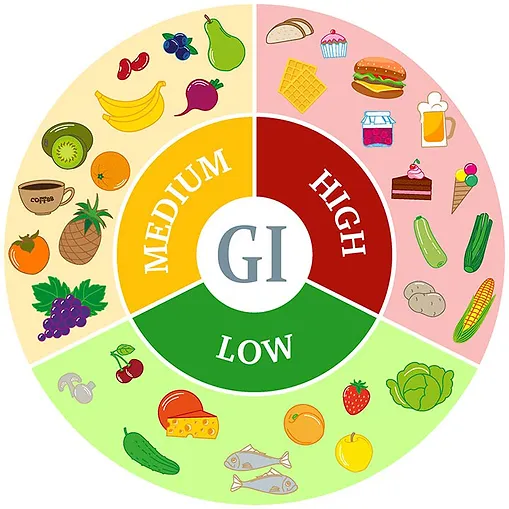
I previously established just a few of the many health dangers of consuming high-glycemic foods. Let’s look at examples of high-glycemic foods and their relationship with insulin resistance (metabolic syndrome) and obesity.
The high glycemic foods
The Glycemic Index (GI) gives a number value to foods relative to glucose itself, which is 100 on the GI scale. It ranks food as to how quickly they get absorbed across your intestinal wall and into your blood. As a general rule:
Low GI foods are below 55
Moderate GI foods are 56-70
High GI foods are above 70.
Here are some examples of foods and their GI score:
Glucose 100
Mashed potato 87
Rice milk 86
Baked potato 85
Cornflakes 81
Watermelon 76
White bread 71
Sucrose 65
White rice 64
Honey 61
Pineapple 59
Muesli cereal 57
Sweet corn 54
Banana 51
Spaghetti 42
All-bran cereal 42
Boiled carrots 39
Raw apple 36
Soy milk 34
Kidney beans 28
Peanuts 16
Fructose 15
You will find it interesting to see the GI of many other foods listed on this Harvard website here: https://www.health.harvard.edu/diseases-and-conditions/glycemic-index-and-glycemic-load-for-100-foods.
Note that foods high on the glycemic index (GI) are not only high in sugar but are also low in fiber and micronutrients. Worse, such foods are easy to consume in larger amounts, which is called the glycemic load.
High glycemic foods and insulin resistance
We know that consuming high-glycemic foods spikes your blood sugar, which in turn stimulates insulin secretion.[1] As a quick review, insulin is the all-important hormone for each cell of your body; it is the “key” that opens the gate (on the cell membrane) for glucose to enter. It is produced and excreted from your pancreas. In addition to causing sugar to enter the cell for energy production, it also stimulates your liver to store glucose (as glycogen).
What’s so bad about these repeated insulin surges? Repeated insulin surges lead to insulin resistance (insulin stops being effective). What happens to blood sugar in this case?—It remains elevated in the blood stream known, a condition known as diabetes The insulin resistance therefore, is the main problem behind metabolic syndrome. Allow me to explain more about metabolic syndrome.
Metabolic syndrome
In 1998 the World Health Organization defined “metabolic syndrome” as the combination of hypertension, low HDL, high triglycerides, insulin resistance, glucose intolerance or type 2 diabetes, high waist-to-hip ratio, and albumin protein in the urine (microalbuminuria).
Remember that high glycemic food consumption causes:
increased production of free fatty acids and fat storage (obesity). It is thought that your body changes sugar into 2 to 5 times more fat in the bloodstream than it does starch[2] (starch is complex carbohydrate that does not surge insulin nor cause obesity)
decreased fat oxidation (i.e. fat does not get used as an energy source)
2 hours after consuming high glycemic foods (e.g. a glazed donut) the nutrients are gone but the insulin surge remains…so you get a drop in your blood sugar, which then triggers hunger even more
It is known that high glycemic foods increase the amount of food that you eat[3]
Therefore, high glycemic food consumption directly promotes metabolic syndrome[4] and obesity.
Advantages of a low glycemic diet – some studies
People dieting on a Low-GI diet had many advantages over those on a high-GI diet even though both groups lost the same amount of weight:
Low-GI dieters lost more body fat
Low-GI dieters lost less muscle
Low-GI dieters’ decline in calorie burning was half that of high-GI dieters[5]
Low-GI people kept the weight off better after calorie restriction was lifted
Low GI diet people had better satiety[6]
Furthermore, in a crossover study[7] of two groups of men who spent equal time on a low glycemic diet as they did a high glycemic diet there was equal weight loss, but the low-GI diet period resulted in greater fat loss and lower waist circumference compared to their high-GI diet period.
Now when you add a high-fiber component to the diet, you have even more benefits.
I’d like to share more about the power of high-fiber foods in my next article.
Michael Cutler, M.D.
[1] Beck, Nielsen H, Pedersen O, Schwartz S. “Effects of Diet on the Cellular Insulin Binding and the Insulin Sensitivity in Young Healthy Subjects." Diabetes. 1978;15:289-296. [2] Nutrition Health Review. Fall 85. Sugar Changes into Fat Faster than Fat.” [3] Allen S. Levine, Catherine M. Kotz, and Blake A. Gosnell . “Sugars and Fats: The Neurobiology of Preference “J. Nutr.2003 133:831S-834S. [4] Yoo, Sunmi et al. “Comparison of Dietary Intakes Associated with Metabolic Syndrome Risk Factors in Young Adults: the Bogalusa Heart Study” Am J Clin Nutr. 2004 Oct;80(4):841-848. [5] Bupropion SR in obesity: A randomized double-blind placebo-controlled study. Gadde KM, et al. Duke University Medical Center. Presented at the American Psychiatric Association annual meeting, May 18, 1999. [6] Munro, JF, et al. "Comparison of Continuous and Intermittent Anorectic Therapy in Obesity", British Medical Journal 1:352-354,1968. [7] Munro JF. Clinical aspects of the treatment of obesity by drugs: a review. Int J Obes. 1979;3(2):171?180.








